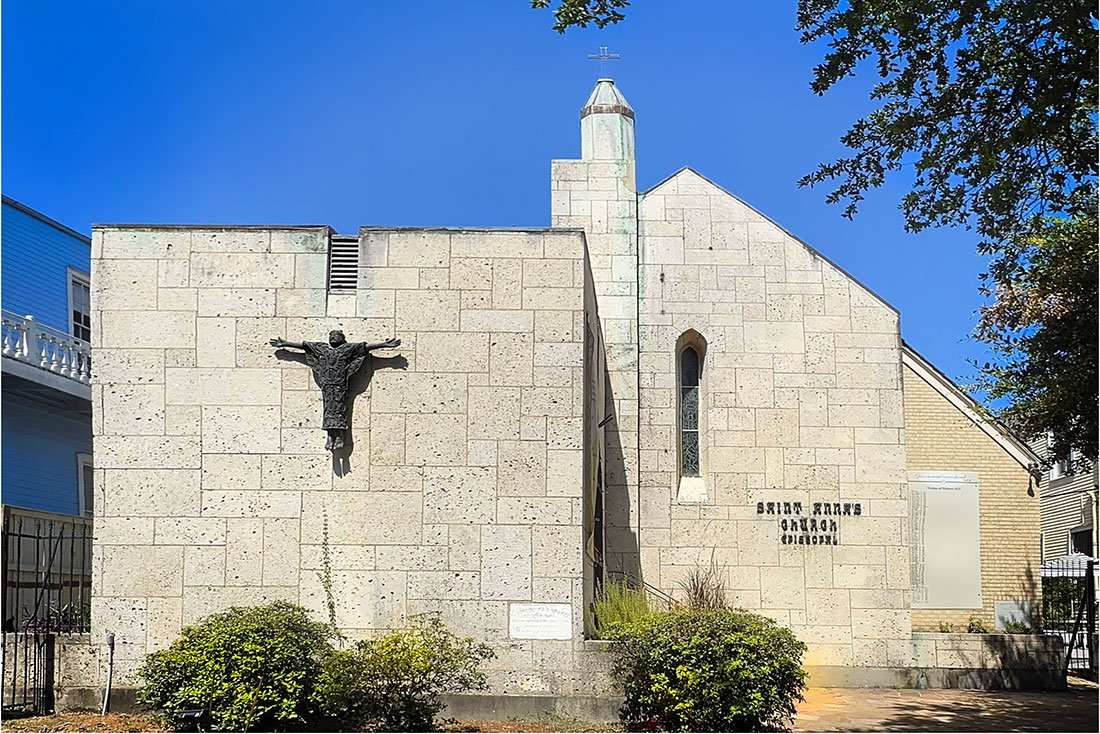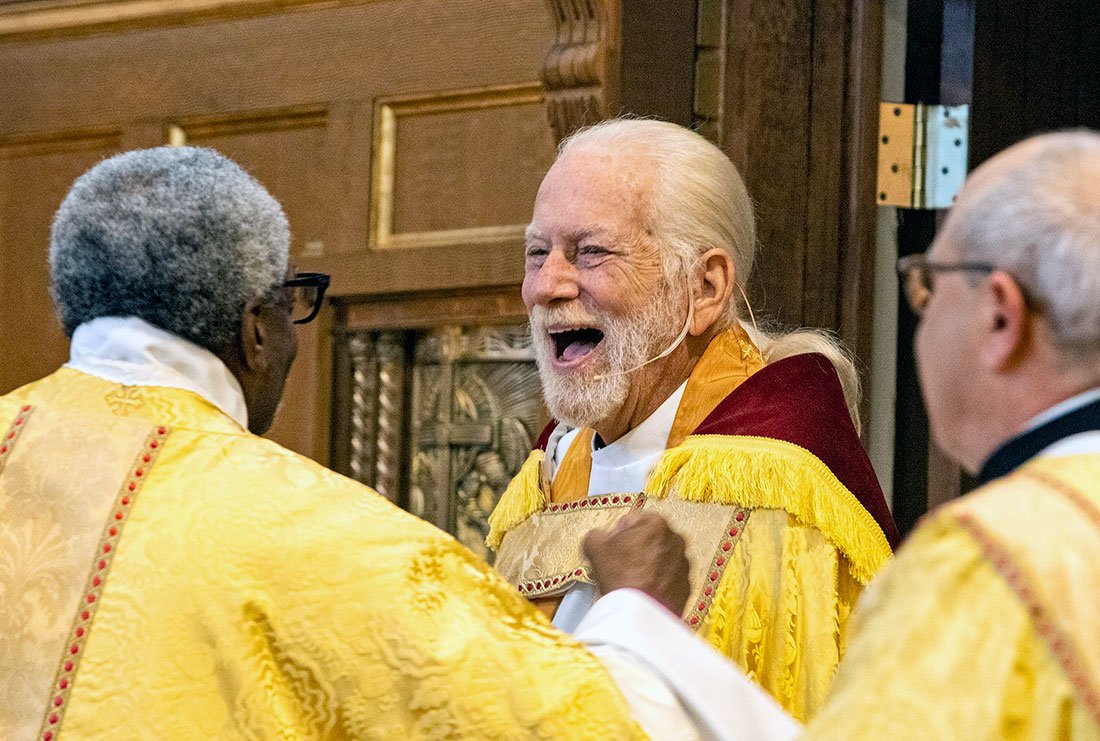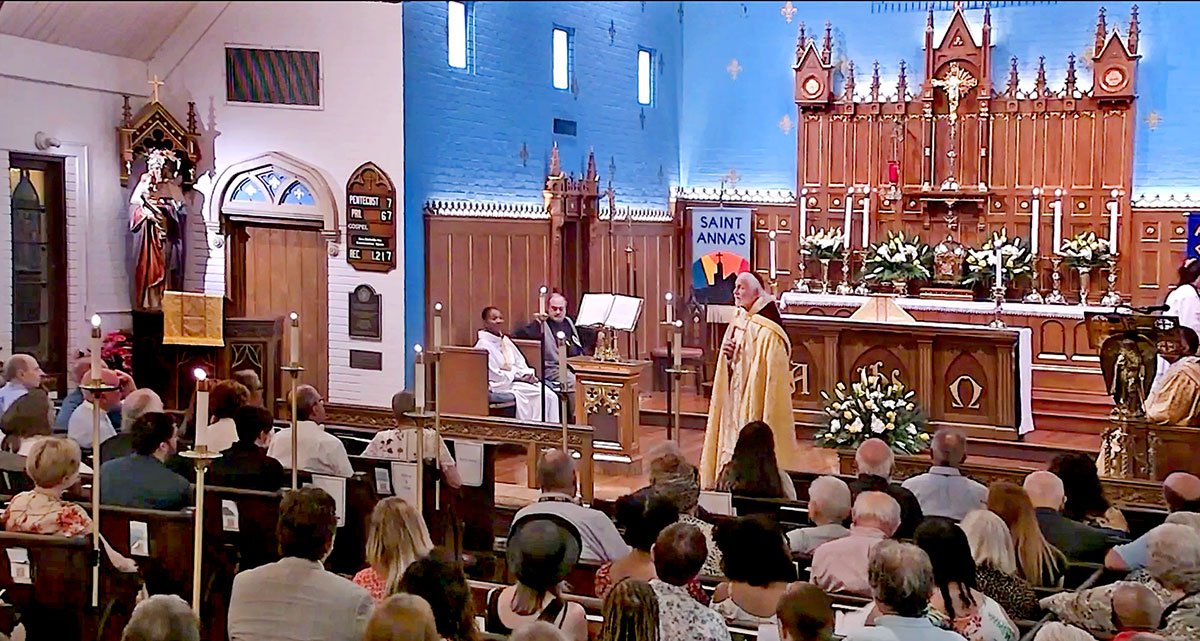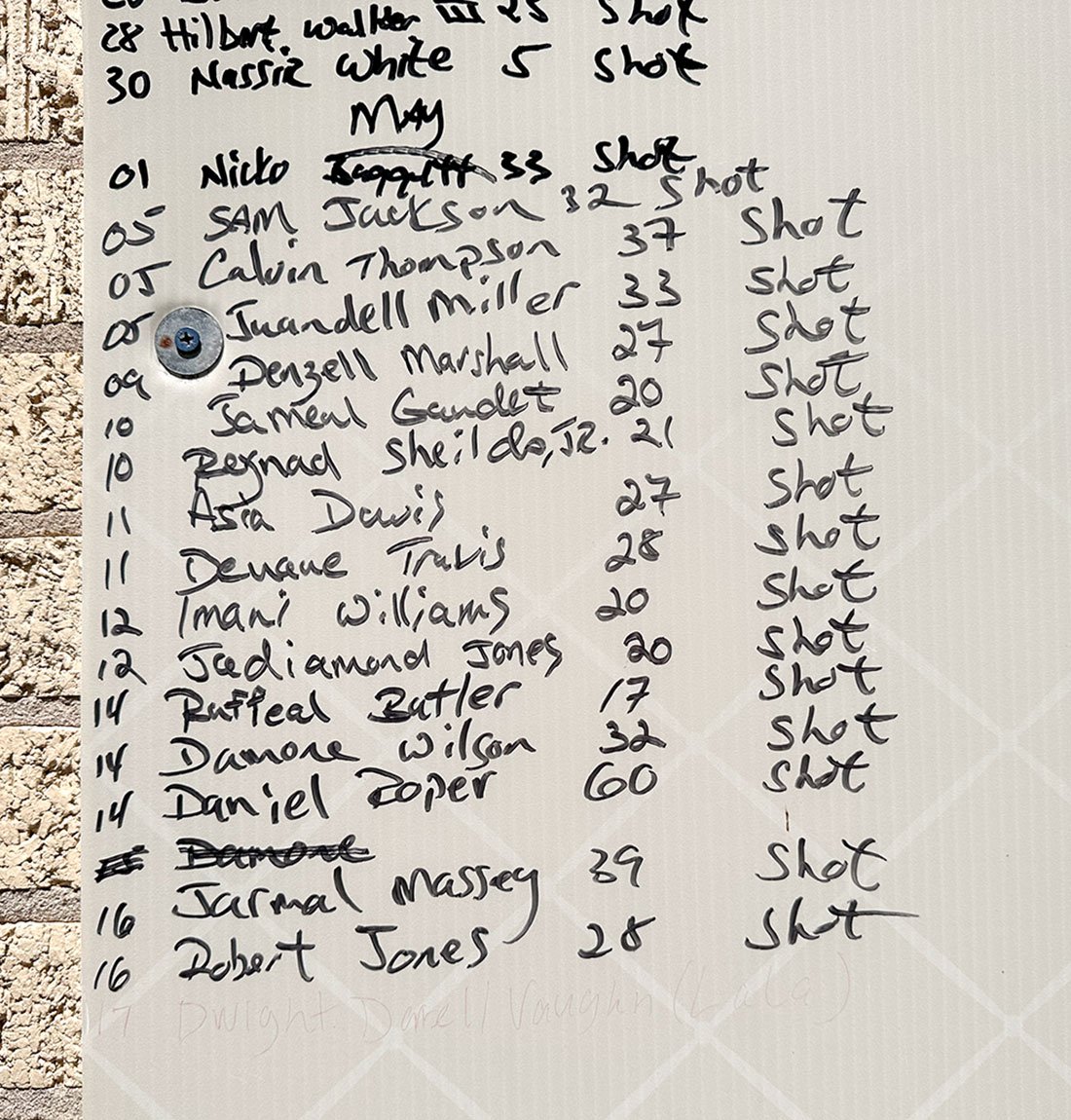St Anna’s Episcopal Church: An Unorthodox Beacon of Metanoia
St. Anna’s on Esplanade Avenue, by Ellis Anderson
August 2023In a parish already known for acceptance, Hurricane Katrina’s heartbreak provided an impetus for a new all-inclusive policy – one that made St. Anna’s a center of hope amid despair.
-By Bethany Ewald Bultman
Farewell to Father Bill
As African drummers summoned the St. Anna’s congregation to prayer on a steamy July evening, I reflected on the impact of this righteously idiosyncratic Episcopal parish. The church’s location seems to reflect its ministries. It is situated just outside the French Quarter on Esplanade Avenue, where the historic Tremé and 7th Ward neighborhoods meet. Down the block in one direction is the iconic Black-owned eatery, Li’l Dizzy’s. In the other, is the LGBTQ+ activist headquarters, the pink Fairie Playhouse.
A few months ago, on the Feast of St. Anna’s, the congregation had come together to worship for its 177th year. This day, the church is celebrating a retirement mass for Father William Terry and the Feast of Saint Anne, the mother of Mary. Joining in the service is Louisiana’s first female Episcopal Bishop, The Rt. Rev Shannon Duckworth. Graduates of Saint Anna’s after-school program and their families crowded in next to parishioners to wish Father Terry well.
Father Bill, center, image, courtesy St. Anna’s.
In true St. Anna’s invigorating style, the high mass was a soul-satisfying, ecclesiastical gumbo of ritual, with Anglican hymns sung by its magnificent choir, thick clouds of incense, and traditional prayers – reworded to reflect equity and inclusion. The service was capped off with a rousing rendition of the old-time gospel classic, “This Little Light of Mine.” All the while, the sluggish air conditioning made a valiant effort to compete with the late July humidity.
This night, I suspect the standing-room-only congregation was unlike any other in the Anglican church world. Dapper gents in seersucker suits and mature ladies in Easter-egg-colored linen frocks received communion, kneeling beside members of The Sisters of Perpetual Indulgence, the queer and trans charitable organization formed nationally in 1979 as a protest performance movement. A few visiting tourists were harmoniously passing the peace with at least one member of the Lords of Leather (not in leather on this hot night, but in Madras plaid Bermuda shorts, should you be curious).
Father Bill at his final service at St. Anna’s, image courtesy St. Anna’s.
As an ambient Episcopalian, I had drifted away from the old-world dogma of the historic church I grew up in. St. Anna’s has fanned those latent embers, for me and for many others. For while the Episcopal church is not known for changing its ways, this parish has certainly done so, through a process called metanoia. Metanoia is a Greek term with several meanings. One definition is “a change of heart.” The other is “atonement.” Both definitions apply to the church’s history.
Somehow this parish balances the paradox of historic Anglican rituals with the radical love of community. Things that might be viewed elsewhere as contradictions, at St. Anna’s translate as moral imperatives. The church’s life-changing mission – one that continues to evolve today – was set in motion by its response to Hurricane Katrina.
St. Anna’s After Katrina
In February 2003, Fr. William H. Terry was ordained as an Episcopal priest after a career in the insurance business. A native New Orleanian, Fortier High graduate and Navy veteran, he was also a married father with grown children. By July 2003 he was officially installed at St. Anna’s, his first parish as rector, and soon became known as “Father Bill.”
A few months later in November 2003, the state's bishop, Charles Jenkins, was one of the minority of the fifty bishops who voted against the election of the openly gay Rev. V. Gene Robinson to lead the American Church. St. Anna’s new rector was unprepared for the task of mollifying the members of the St. Anna's congregation who were openly gay with the policies of Louisiana's Episcopal Diocese.
Father Bill was still firming his footing in the unconventional parish when Hurricane Katrina roared into the Gulf Coast just two years later, on August 29, 2005. Numerous levee breaches left 80 percent of New Orleans under water – in some places 15 feet deep – for weeks. In the wake of the floods, Father Bill gave thanks that St. Anna’s was one of the few un-flooded churches in New Orleans.
In those early fall Sundays of 2005, a small congregation worshiped in Father Bill’s carport on the North Shore until the city allowed residents to return. The rector had to face reality: St. Anna’s was left with a congregation of less than a dozen people – those few who were able to come home after the flood. Healthcare, education, food resources and the infrastructure were frayed. Violent crime became a way of life.
“Bent, not broken” became one of the slogans adopted by locals like Father Bill on the front lines of the recovery. On December 4, 2005, the rector hosted a prayer service in the church and a second line to honor the first responders. By mid-December (Advent), St. Anna’s held a mass to mourn the loss of pets during Katrina. The church was packed.
Organically, St. Anna’s purpose, mission and mandate merged into one imperative: provide comfort and hope to a city experiencing extraordinary loss and PTSD. There was no manual for disaster relief of that magnitude, so the new rector drew on his parish’s unique history and the fortitude of neighborhood residents.
Over the coming months, this small Treme parish evolved into one of the most active churches in the country for the delivery of boots-on-the-ground frontline aid and recovery support. Ten churches and several community leaders temporarily headquartered at St. Anna’s to marshal recovery resources for the flooded areas, particularly the Lower Ninth Ward and Gentilly.
The parish became a clearinghouse for clothing, water, and immediate medical aid for those struggling to rebuild their lives. Churches from all over the United States sent groups to muck out houses and rebuild. Father Bill hired ladies from the surrounding neighborhoods to prepare meals for the volunteers and parishioners helped them find temporary housing during their mission trips.
St. Anna’s Mobile Medical Mission
St. Anna’s Mobile Medical Mission (SAMM) evolved to problem-solve through organizational collaborations thanks to the vision of parishioner Diana Haase Meyers, RN, a dedicated nurse whose own home had been flooded. With Meyer’s leadership, St. Anna’s joined forces with Ascension DePaul Health Centers, Tulane University School of Medicine, acupuncturists, and dozens of schools and church groups volunteering for the recovery.
Offering free medical care, health screenings, health education, and medical navigation, SAMM empowered underserved populations by providing access to services. During the next decade, it filled the healthcare gap between the lack of access prior to 2005 and the emergence of a viable network of New Orleans community clinics by 2015. In 2007, St. Anna’s Mobile Medical Mission was recognized by CityBusiness as a Nonprofit Innovator of the Year.
Under the free-wheeling leadership of Father Bill, St. Anna’s parish and the vestry evolved into another force for the good of the surrounding community. It began serving as a halfway house of sorts, one that seemed to have merged a Katrina recovery consortium and a bastion of unapologetic high church ritual. Most significantly, the church instituted a formal policy: All were welcome. No one would be shunned.
That change in policy began to manifest in unique ways. For example, Dr. Jimbo Walsh, a former professor at Columbia University, vice president of the Guild of Composers and noted musician, served as music director during the early days of St. Anna’s rebuilding renaissance. He was also an avowed agnostic. His Jewish wife, Janna Saslaw, an associate professor of Music Theory at Loyola University, sang in the choir.
And in December 2007, Joyce Eskamire-Jackson, a long-standing member of St. Anna’s, became the first African-American female deacon in the Diocese of Louisiana and on the Gulf Coast. She and parishioner Lola Maloof guided the development of what continues as St. Anna’s Food Pantry.
Drawing of St. Anna’s by Carol Peebles, 2019, courtesy Carol Peebles.
Mission to Musicians
Representing the New Orleans Musicians Clinic (NOMC), I first met with Father Bill at St. Anna’s in early March 2006. Post-Katrina, our NOMC clinic had become one of the first in the city to reopen. By Thanksgiving 2005 – via an innovative partnership with the LSU Healthcare Network – it was treating musician patients and culture bearers in a former pediatric clinic on Prytania Street, near Touro Infirmary.
The trouble was, it was difficult to get the word out about our resumption of care to NOMC’s patients. Katrina’s flood waters had washed away all the medical records since our founding in 1998. We lost our clinic on Gravier Street and access to our bank accounts. Many of our patients and LSU physicians were scattered all over the country.
At that first meeting, Father Bill and I discussed hope. We suspected that if we didn’t do something right away, New Orleans would face cultural extinction or cultural appropriation by the well-meaning newcomers who were moving to the city in record numbers, repopulating the former neighborhoods of our displaced culture bearers.
We believed that a NOMC partnership with St. Anna’s could help restore the sense of community the flood waters had washed away, in part by establishing a consistent meeting place for musicians and culture bearers, a place that also offered access to medical care.
We also discussed the possibility that St. Anna’s could serve as a venue for more than ecclesiastical music. During the first months of 2006, New Orleans Musicians Assistance Foundation (NOMAF) began building an endowment with an ambitious goal: To fund our patients so they could keep performing until traditional music venues could reopen. The free performances would help support the musicians financially while uplifting the community. In a sense, it was a mental-health initiative, because it offered hope that musicians could eventually sustain themselves economically again.
Father Bill and I dreamed up a plan for a musician-centered mass on Wednesday evenings, followed by a home-cooked hot meal and a jam session. By Jazz Fest 2006, the Wednesday night events had grown from a ragtag group of participating street musicians into the thriving St. Anna’s Mission to Musicians (M2M). Attendances became so crowded that the line for dinner trailed outside the church to Esplanade Avenue.
Lillian Boutté and Yaya at one of the M2M events in 2007, image courtesy St. Anna’s
In those early days of M2M, St. Anna’s was one of the only venues to offer live music together with a good meal (free for some, “pass the hat” for those who could afford it) – and both spiritual and medical support. During this time Loyola University offered a legal clinic at M2M. Massage therapists and ear acupuncturists from all over the country not only came to our Wednesday night events but also trained the NOMC medical staff and obtained licensure for them. M2M even hosted a volunteer who repaired damaged instruments.
Among the musical greats who played at St. Anna’s were several generations of the Boutte family, Germaine Bazzle, Kermit Ruffins, Sunpie Barnes, Al “Carnival Time” Johnson, Tremé Brass Band with Uncle Lionel, and Zydepunks. During the course of M2M, more than 300 checks were issued to local musicians and 6,000 plates of food were served.
In the spirit of St. Anna’s metanoia, there was at least one convert during this time. In particular, the Episcopal Bishop Charles Jenkins prayerfully addressed the congregation, begging for forgiveness for his actions of exclusion of the past.
“St. Anna’s is a true example of what the Episcopal church should strive for,” he said.
The Murder Board and the Rose Ministry
“The Tree of Life: Victims of Violence Memorial” by Michael Pert, photo by Ellis Anderson
The 2023 victims
But the church was only an island of peace in a city that was not a safe or hospitable place. With the largest and fastest displacement of a population in US history (including tax and business bases), crime seemed to know no bounds. Poverty became endemic. New Orleans’ ranked #1 in the USA for urban blight. More than a year after the storm, 175,000 Black New Orleanians were still unable to return to the city. The infrastructure for police, medical care, schools, and city services had been disrupted and in some cases, destroyed.
By 2007, New Orleans was ranked as the #1 city for murders in the United States. St. Anna’s once more stepped up. The Rev. Elaine Clemments, a deacon in training at the time, came up with the ideas for the Murder Board and the Rose Ministry, programs which sought to humanize this ongoing tragedy. Both ministries eventually received national attention, speaking eloquently for the terrible plight of New Orleans.
The Murder Board listed the names of each victim on a board in front of the church. Some of the musicians who had performed at the M2M had family members whose names appeared on the board. Sometimes their own names were added. Father Bill never said no to officiating at one of their funerals or comforting their families.
Under the Rose Ministry, for the first several years, a rose for each new victim was delivered weekly to the mayor, the chief of police, and the district attorney as a reminder of the human toll of violence. Each week, the victims’ names and those of the perpetrators were read at each service at St. Anna’s, and the congregation prayed for them and their families.
A permanent memorial was eventually commissioned from artist Michael Pert, titled “The Tree of Life: Victims of Violence Memorial.” It was installed at St. Anna’s in 2021, serving as a voice for justice for the victims and their families. Today, it bears the names of the more than 3,000 murder victims killed over the past 18 years.
Anna’s Arts for Kids
Anna’s Place NOLA Summer Camp, image courtesy St. Anna’s.
Trying to find a solution to the violence epidemic brought about the founding of another ministry in 2010, “Anna’s Arts for Kids.” A devoted and highly qualified community activist and arts professional, Darryl Durham, was a professional clarinetist and one of the musicians who attended M2M. He suggested that the Harlem School of Fine Arts, where he had formerly served as CEO before moving to Tremé, could be duplicated at St. Anna’s.
Beyond reaching out to at-risk children in Treme with art and music classes, the program at St. Anna’s sought to foster a sense of self-worth, self-discipline, and appropriate social responses to the challenges of post-Katrina life. Soon parents were asking for academic assistance for their children, which expanded the scope of the program.
Renamed Anna’s Place NOLA, the program now offers a broad curriculum emphasizing basic reading skills, STEM, a NASA collaboration, the arts, community awareness, secondary education guidance, tutoring for college entrance examinations, and a litany of other social and educational supports for children ages 5-18.
On October 7, Anna’s Place NOLA will officially have a new home - the Dodwell House Community Resource Center at 1519 Esplanade Avenue, just a few blocks from the church. For over a decade, St. Anna’s has been working to renovate this 1846 house to serve the community and become a “place of hope and possibility.”
Whomever the new rector of St. Anna’s will be, they will stand on the shoulders of ancestors and predecessors as they undertake stewardship of this parish. And may they hold metanoia dear as this congregation continues their work of community inclusion and justice.
Join our Readers’ Circle now!









